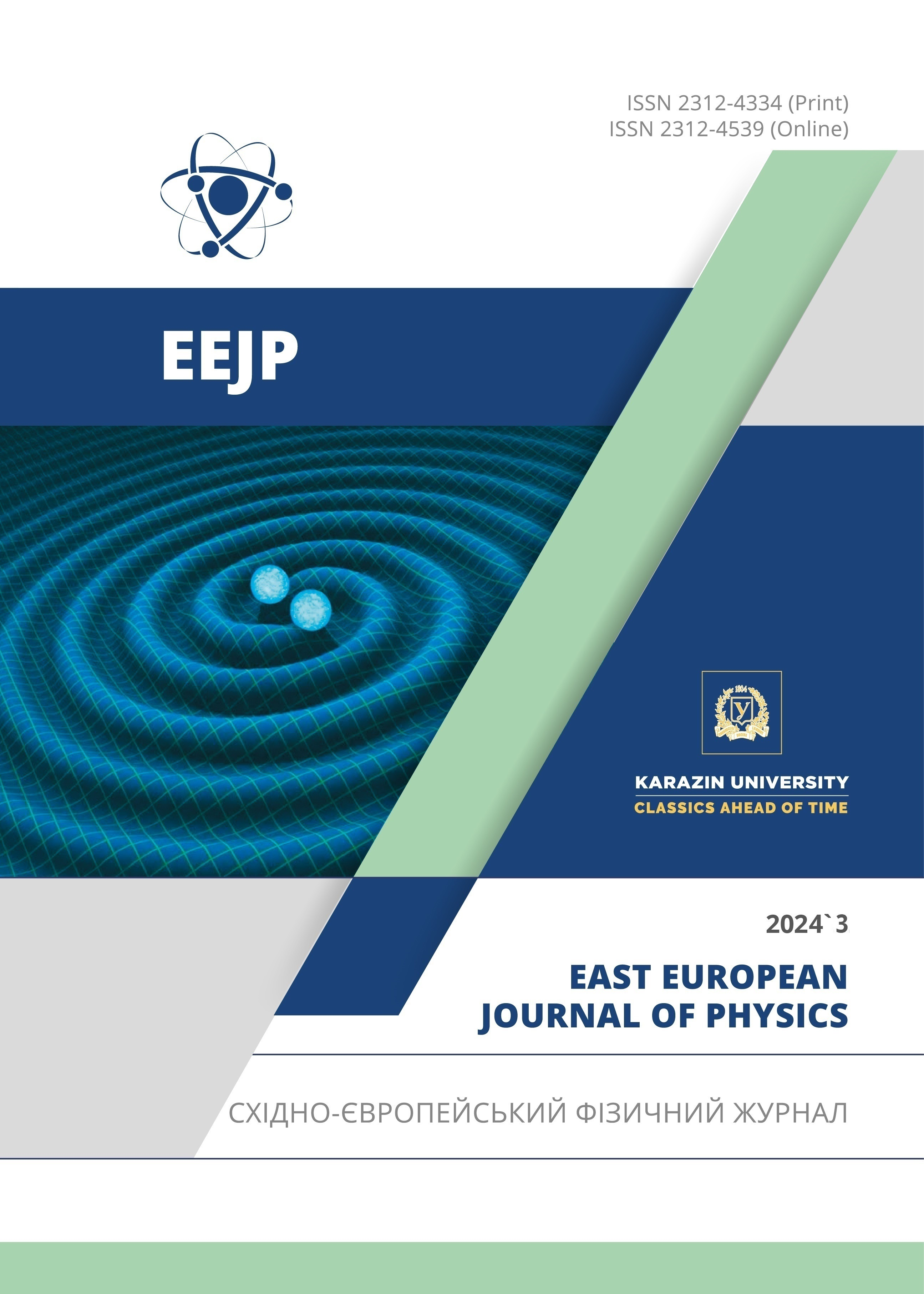Preparation of Calcium Titanate Perovskite Compound, Optical and Structural Properties
Abstract
In this work, we have successfully fabricated a calcium titanate perovskite compound. The resulting CaTiO3 compound was studied by preparing samples by compacting it in a powder state and using a Pousson device. The distance between the planes dhkl, Miller indices (hkl), degree of crystallinity and amorphism, structure and lattice parameters of the calcium titanate perovskite compound were determined using an X-ray diffractometer. Also, according to the results of FT-IR analysis, the formation of CaTiO3 perovskite is confirmed as a result of the study of molecular vibrations. The main broad peaks are observed in the range of 680÷400 cm-1, the absorption band at the wave number of 543,93 cm-1 corresponds to the specific stretching vibrations of Ti-O bonds and indicates the formation of the CaTiO3 perovskite type structure implies. Based on the results of these measurements, it will be possible to use semiconductor compounds in the future to create nanofilms by magnetron sputtering.
Downloads
References
S. Dahlke, J. Sterling, and C. Meehan, “Policy and market drivers for advancing clean energy,” Advances in Clean Energy Technologies, 451-485 (2021). https://doi.org/10.31219/osf.io/hsbry
J. Grove, “Triple miracle' sees huge rise in EU funds for frontier research,” Times Higher Education, 28, (2011).
M.T. Normuradov, Sh.T. Khozhiev, K.T. Dovranov, Kh.T. Davranov, M.A. Davlatov, and F.K. Khollokov, “Development of a technology for the production of nano-sized heterostructured films by ion-plasma deposition. Structure of materials,” Ukr. J. Phys. 68(3), (2023). https://doi.org/10.15407/ujpe68.3.210
F. Giustino, and H.J. Snaith, “Toward lead-free perovskite solar cells,” ACS Energy Letters, 1(6), 1233-1240 (2016). https://doi.org/10.1021/acsenergylett.6b00499
D.D. Nematov, A.S. Burhonzoda, and F. Shokir, “Analysis of the structural characteristics and optoelectronic properties of CaTiO3 as a non-toxic raw material for solar cells: a DFT study,” (2020). https://doi.org/10.48550/arXiv.2210.14835
S.S. Gaikwad, A.V. Borhade, and V.B. Gaikwad, “A green chemistry approach for synthesis of CaTiO3 Photocatalyst: its effects on degradation of methylene blue, phytotoxicity and microbial Study,” Der Pharma Chemica, 4(1), 184-193 (2012). https://www.derpharmachemica.com/pharma-chemica/a-green-chemistry-approach-for-synthesis-of-catio3-photocatalyst-its-effects-on-degradation-of-methylene-blue-phytotoxic.pdf
M.Yu. Tashmetov, F.K. Khallokov, N.B. Ismatov, I.I. Yuldashova, I. Nuritdinov, and S.Kh. Umarov, “Study of the influence of electronic radiation on the surface, structure and Raman spectrum of a TlInS2 single crystal,” Phys. B, 613, 412879 (2021). https://doi.org/10.1016/j.physb.2021.412879
M.Yu. Tashmetov, F.K. Khallokov, N.B. Ismatov, I.I. Yuldashova, and S.Kh. Umarov, “Electronic irradiation of TlInSxSe2-x (x 1): Morphology, structure and raman scattering,” Intern. J. Modern Phys. B, 35(28), 2150289 (2021). https://doi.org/10.1142/S0217979221502891
L. Smrčok, V. Langer, M. Halvarsson, and S. Ruppi, “A new Rietveld refnement of k-Al2O3,” Zeitschrift fuer Kristallographie 216, 409 (2001). https://doi.org/10.1524/zkri.216.7.409.20361
W. Dong, Q. Bao, X. Gu, and G. Zhao, “Controlled synthesis of flower-like CaTiO3 and effects of morphology on its photocatalytic activities,” Journal of the Ceramic Society of Japan, 123(8), 643-648 (2015). https://doi.org/10.2109/jcersj2.123.643
M.T. Normuradov, Sh.T. Khozhiev, L.B. Akhmedova, I.O. Kosimov, M.A. Davlatov, and K.T. Dovranov, “Peculiarities of BaTiO3 in electronic and X-Ray analysis,” E3S Web Conf. 383, 04068 (2023). https://doi.org/10.1051/e3sconf/202338304068
Q. Fan, J. Yang, C. Deng, J. Zhang, and J. Cao, “Electronic structure and optical properties of CaTiO3: An ab initio study,” in: Proc. SPIE 9794, Sixth International Conference on Electronics and Information Engineering, 97942I (2015). https://doi.org/10.1117/12.2203278
D. Parajuli, N. Murali, K. Samatha, N.L. Shah, and B.R. Sharma, “Structural, Morphological, and Textural Properties of Coprecipitated CaTiO3 for Anion Exchange in the Electrolyzer,” Journal of Nepal Physical Society, 9(1), 137-142 (2023). https://doi.org/10.3126/jnphyssoc.v9i1.57751
I.R. Bekpulatov, G.T. Imanova, B.E. Umirzakov, K.T. Dovranov, V.V. Loboda, S.H. Jabarov, I.X. Turapov, et al., “Formation of thin Crsi2 films by the solid-phase ion-plasma method and their thermoelectric properties,” Materials Research Innovations, (2024). https://doi.org/10.1080/14328917.2024.2339001
K.T. Dovranov, M. Normurodov, Kh.T. Davranov, and I.R. Bekpulatov, “Formation of Mn4Si7/Si(111), CrSi2/Si(111), and CoSi2/Si(111) Thin Film and Evaluation of Their Optically Direct and Indirect Band Gap,” Ukrainian Journal of Physics, 20(69), (2024). https://doi.org/10.15407/ujpe69.1.20
M. Mostafa, Z.A. Alrowaili, M.M. Al Shehri, M. Mobarak, and A.M. Abbas, “Structural and Optical Properties of Calcium Titanate Prepared from Gypsum,” Journal of Nanotechnology, 2022, 6020378 (2022). https://doi.org/10.1155/2022/6020378
A. Kumar, C. Schuerings, S. Kumar, A. Kumar, and V. Krishnan, “Perovskite-structured CaTiO3 coupled with g-C3N4 as a heterojunction photocatalyst for organic pollutant degradation,” Beilstein J. Nanotechnol. 9, 671–685 (2018). https://doi.org/10.3762/bjnano.9.62
A.A.A. Torimtubun, A.C. Augusty, E. Maulana, and L. Ernawati, “Affordable and sustainable new generation of solar cells: calcium titanate (CaTiO3)–based perovskite solar cells,” E3S Web of Conferences, 67, 01010 (2018). https://doi.org/10.1051/e3sconf/20186701010
M. Rizwan, Z. Usman, M. Shakil, S.S.A. Gillani, S. Azeem, H.B. Jin, C.B. Cao, et al., “Electronic and optical behaviour of lanthanum doped CaTiO3 perovskite,” Materials Research Express, 7(1), 015920 (2020). https://doi.org/10.1088/2053-1591/ab6802
Copyright (c) 2024 Khujamkul T. Davranov, Muradulla T. Normuradov, Muzaffar A. Davlatov, Kuvondiq T. Dovranov, T.U. Toshev, N.A. Kurbonov

This work is licensed under a Creative Commons Attribution 4.0 International License.
Authors who publish with this journal agree to the following terms:
- Authors retain copyright and grant the journal right of first publication with the work simultaneously licensed under a Creative Commons Attribution License that allows others to share the work with an acknowledgment of the work's authorship and initial publication in this journal.
- Authors are able to enter into separate, additional contractual arrangements for the non-exclusive distribution of the journal's published version of the work (e.g., post it to an institutional repository or publish it in a book), with an acknowledgment of its initial publication in this journal.
- Authors are permitted and encouraged to post their work online (e.g., in institutional repositories or on their website) prior to and during the submission process, as it can lead to productive exchanges, as well as earlier and greater citation of published work (See The Effect of Open Access).








